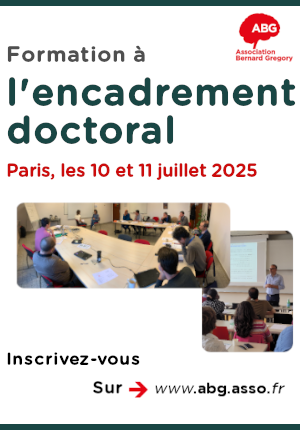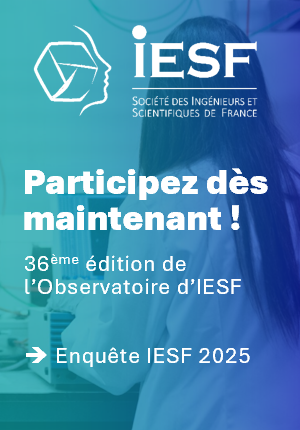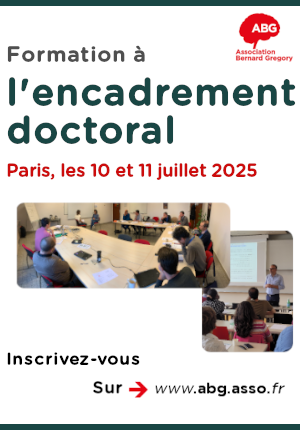Habitat sensible et intelligent pour l'aide au maintien à domicile : contribution à l'évaluation de la perte d'autonomie par IOT et IA // Sensitive and smart housing to help people stay at home: a contribution to the assessment of loss of autonomy using I
|
ABG-131265
ADUM-65304 |
Sujet de Thèse | |
| 18/04/2025 | Contrat doctoral |
Université de Savoie Mont-Blanc
ANNECY-LE-VIEUX - France
Habitat sensible et intelligent pour l'aide au maintien à domicile : contribution à l'évaluation de la perte d'autonomie par IOT et IA // Sensitive and smart housing to help people stay at home: a contribution to the assessment of loss of autonomy using I
- Electronique
habitat intelligent, e-santé, mesure, incertitude, intelligence artificielle (AI)
smart habitat, E-health, measurement, uncertainty, Artificial Intelligence (AI)
smart habitat, E-health, measurement, uncertainty, Artificial Intelligence (AI)
Description du sujet
Ce sujet s'inscrit dans le défi sociétal qu'est l'aide au maintien à domicile de personnes vulnérables. Les praticiens tels que médecins, gériatres, kinésithérapeutes travaillant dans un contexte de pénurie de main d'œuvre, l'utilisation des solutions technologiques et numériques permet d'optimiser ces ressources. La réalisation de mesures continues dans un environnement naturel, non stigmatisant et a priori non intrusif, permet d'obtenir des informations pertinentes et objectives sur le comportement des personnes âgées [Abdel-Khalek 2024]. Les indicateurs liés à la marche sont incontournables et largement exploités pour évaluer la fragilité de la personne [AI Faisal 2023]. Nous nous proposons de mesurer ces mouvements au domicile des personnes à partir de dispositifs développés au laboratoire. Ils sont formés par un réseau de capteurs bas niveau et non intrusifs, tel que des capteurs électrostatiques [Pichon 2024] ou infra-rouge [Abdel et al 2021], connectés en IoT, peu coûteux pour une large diffusion. Associés à des méthodes d'intelligence artificielle, en particulier des algorithmes d'apprentissage profonds, nous obtenons des modalités de plus haut niveau liées à l'actimétrie : la vitesse de déplacement, les longueurs de foulées, voire certains mouvements corporels. Les objectifs de la thèse sont de mettre au point le dispositif bas coût pour une grande diffusion et destinés à être placés au domicile avec la caractérisation des mesures obtenues et également d'étudier les solutions pour rendre invariant les algorithmes d'apprentissage profond aux nombres d'entrées.
------------------------------------------------------------------------------------------------------------------------------------------------------------------------
------------------------------------------------------------------------------------------------------------------------------------------------------------------------
This subject is part of the societal challenge of helping vulnerable people to remain in their own homes. Practitioners such as doctors, geriatricians and physiotherapists are working in a context of manpower shortages, and the use of technological and digital solutions makes it possible to optimize these resources. By taking continuous measurements in a natural, non-stigmatizing and a priori non-intrusive environment, we can obtain relevant and objective information on the behavior of the elderly [Abdel-Khalek 2024]. Walking-related indicators are essential and widely used to assess a person's frailty [AI Faisal 2023]. We propose to measure these movements in people's homes using devices developed in the laboratory. They are formed by a network of low-level, non-intrusive sensors, such as electrostatic [Pichon 2024] or infra-red [Abdel et al 2021], connected in IoT, inexpensive for wide distribution. Combined with artificial intelligence methods, in particular deep learning algorithms, we obtain higher-level modalities linked to actimetrics: movement speed, stride lengths and even certain body movements. The aims of the thesis are to develop a low-cost device for widespread use in the home, with characterization of the measurements obtained, and also to study solutions for making deep learning algorithms invariant to the number of inputs
------------------------------------------------------------------------------------------------------------------------------------------------------------------------
------------------------------------------------------------------------------------------------------------------------------------------------------------------------
Début de la thèse : 01/10/2025
------------------------------------------------------------------------------------------------------------------------------------------------------------------------
------------------------------------------------------------------------------------------------------------------------------------------------------------------------
This subject is part of the societal challenge of helping vulnerable people to remain in their own homes. Practitioners such as doctors, geriatricians and physiotherapists are working in a context of manpower shortages, and the use of technological and digital solutions makes it possible to optimize these resources. By taking continuous measurements in a natural, non-stigmatizing and a priori non-intrusive environment, we can obtain relevant and objective information on the behavior of the elderly [Abdel-Khalek 2024]. Walking-related indicators are essential and widely used to assess a person's frailty [AI Faisal 2023]. We propose to measure these movements in people's homes using devices developed in the laboratory. They are formed by a network of low-level, non-intrusive sensors, such as electrostatic [Pichon 2024] or infra-red [Abdel et al 2021], connected in IoT, inexpensive for wide distribution. Combined with artificial intelligence methods, in particular deep learning algorithms, we obtain higher-level modalities linked to actimetrics: movement speed, stride lengths and even certain body movements. The aims of the thesis are to develop a low-cost device for widespread use in the home, with characterization of the measurements obtained, and also to study solutions for making deep learning algorithms invariant to the number of inputs
------------------------------------------------------------------------------------------------------------------------------------------------------------------------
------------------------------------------------------------------------------------------------------------------------------------------------------------------------
Début de la thèse : 01/10/2025
Nature du financement
Contrat doctoral
Précisions sur le financement
Concours pour un contrat doctoral
Présentation établissement et labo d'accueil
Université de Savoie Mont-Blanc
Etablissement délivrant le doctorat
Université de Savoie Mont-Blanc
Ecole doctorale
634 Sciences Ingénierie Environnement
Profil du candidat
- Autonomie, inventivité, rigueur, esprit d'initiative.
- Très bonne aisance en programmation, maitrise d'un langage informatique.
- Appétence et connaissances de méthode d'apprentissage automatique (machine learning, deep learning).
- Une aisance dans l'embarqué sur arduino, raspberry pi est requise.
- L'envie d'apprendre de comprendre et d'approfondir au-delà de la réalisation d'une solution.
- Bonne maîtrise de l'anglais
-Autonomy, creativity, rigor, and a proactive mindset. -Strong programming skills and proficiency in at least one programming language. -Interest in and knowledge of machine learning and deep learning methods. - Experience with embedded systems using Arduino or Raspberry Pi is required. -A strong motivation to learn, understand, and go beyond simply delivering a technical solution. - Good command of English.
-Autonomy, creativity, rigor, and a proactive mindset. -Strong programming skills and proficiency in at least one programming language. -Interest in and knowledge of machine learning and deep learning methods. - Experience with embedded systems using Arduino or Raspberry Pi is required. -A strong motivation to learn, understand, and go beyond simply delivering a technical solution. - Good command of English.
31/05/2025
Postuler
Fermer
Vous avez déjà un compte ?
Nouvel utilisateur ?
Besoin d'informations sur l'ABG ?
Vous souhaitez recevoir nos infolettres ?
Découvrez nos adhérents
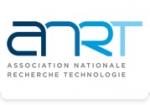 ANRT
ANRT  Institut Sup'biotech de Paris
Institut Sup'biotech de Paris  TotalEnergies
TotalEnergies  SUEZ
SUEZ  Nokia Bell Labs France
Nokia Bell Labs France  Tecknowmetrix
Tecknowmetrix  CESI
CESI  MabDesign
MabDesign 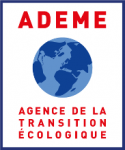 ADEME
ADEME  Laboratoire National de Métrologie et d'Essais - LNE
Laboratoire National de Métrologie et d'Essais - LNE  MabDesign
MabDesign  Groupe AFNOR - Association française de normalisation
Groupe AFNOR - Association française de normalisation  Généthon
Généthon  ONERA - The French Aerospace Lab
ONERA - The French Aerospace Lab  ASNR - Autorité de sûreté nucléaire et de radioprotection - Siège
ASNR - Autorité de sûreté nucléaire et de radioprotection - Siège  Aérocentre, Pôle d'excellence régional
Aérocentre, Pôle d'excellence régional 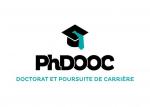 PhDOOC
PhDOOC  CASDEN
CASDEN  Ifremer
Ifremer

